|
|
 |

An In-Depth Look at the Dynojet Chassis Dynamometer
by Hib Halverson |
|
One of my favorite pieces of test equipment is the
Dynojet 248H chassis dynamometer. Projects I’ve done for The Idaho
Corvette Page, Vette Magazine and other media have required a lot
of dynamometer testing and that drives my fondness for the device. It’s
simple to operate, accurate and repeatable. This article will examine
the Dynojet in detail. We’ll look at how it works, what it can do and
what it can’t do. |
|
|
Reducing it to the lowest common denominator: chassis
dynos work by having the car’s drive wheels spin a big metal roller or drum.
Photo: author. |
|
|
|
A dynamometer tests the power of an automotive engine
or powertrain. It measures output shaft or wheel speed and, in some
cases, torque and time. Apply laws of physics to that data and power
output can be calculated. Modern dynos have computers to do the math and
provide the results either on a computer monitor, in printed form or in
a data file.
There are two types of these devices. Engine dynos
couple directly to the engine’s crankshaft. When the engine runs, the
dynamometer exerts a braking force upon it. The force required to hold
the engine at a certain speed equates to torque output. Engine dynos
have one big problem: you have to take the engine out of the car to test
it. For service shops or tuners not doing a lot of specialized engine
work, not having a lot of space to store engineless vehicles or not
wishing to make the capital investment in a dedicated, engine test
facility; engine dynos aren’t very practical nor are they good values.
|
|
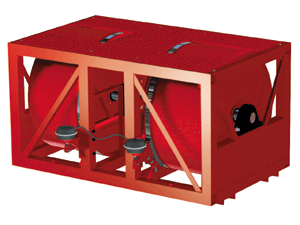 |
The Dynojet 248H revealed. The top
surface is where the car’s wheels sit on the roller. Clearly visible
are the drums and shaft. The two "pots" in the foreground are
the air brakes and the inside edges of both drums are their friction
surfaces. On the right end of the dyno is one of the big, antifriction
bearing assemblies.
Photo: Dynojet Research |
|
|
A chassis dynamometer accommodates an entire vehicle
and allows operation of its powertrain while the vehicle remains
stationary. The car is attached to the dyno with tie-down devices and
its drive wheels sit on a metal roller or a pair of rollers. The rollers
are connected to whatever measuring system the dyno uses to test drive
wheel output.
The chassis dynamometer was developed in 1938 by
Clayton Industries. It was termed a "hydrokinetic" dyno
because it used a water brake to absorb power. Since then, chassis dynos
have been built with water brakes, oil brakes, eddy-current brakes,
generators and other devices which actively absorb power.
While brake-type chassis dynos are great pieces of
equipment, most are expensive, a good part of which is the power
absorption system and its controls. A chassis dyno suitable for testing
today’s high-tech performance cars can cost upwards of $150,000.
Another problem with some brake-type chassis dynos is they lack the
accuracy and repeatability demanded by many performance-aftermarket
manufacturers and tuners.
Dynojet Research of Belgrade, Montana invented the
"inertia" dynamometer in 1989 to test motorcycles. In 1994, it
introduced the first inertia dyno for cars and light trucks, the model
248C. An inertia dyno differs from a brake dyno in several ways: 1) it
has no active power absorption device 2) it’s more accurate, 3) it’s
less expensive, 4) it’s easier on the vehicles being tested and 5) it’s
easier to use. Some of the technology that made an inertia dyno feasible
was the personal computer’s ability to make rapid computations
|
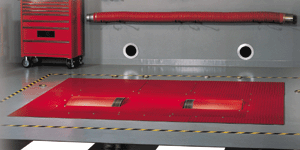 |
A Dynojet 248H in a pit
installation looks like this. You simply roll the car’s drive wheels
on top of the drums, tie the car down and chock the front wheels. You
can drive on backwards or forwards and the dyno can test front- or
rear-drive vehicles.
Photo: Dynojet Research. |
|
|
Because the inertia dyno idea is so simple and
cost-effective and Dynojet has had success marketing the concept, other
manufacturers have recently introduced similar products. An example is
Super Flow’s recent debut of the "AutoDyn", it’s entry in
the inertia dyno market.
During the research for this article, we interviewed
Jim Bell of Kenne-Bell Hi-Tech Performance Products. Bell, known for his
work with high-end, aftermarket supercharger kits, was an early convert
to the Dynojet. Every car or truck his business works on is run on Kenne-Bell’s
Dynojet when it comes in and again when it goes out.
|
|
|
"They (Dynojet Research) towed it
(trailer-mounted demo unit) down here behind a truck," Bell told
us. "We ran a bunch of cars on it. I compared the data to my engine
dyno tests and drag strip tests and, no question, it’s accurate.
"Then I took the one of the vehicles I ran here–this
was a 410hp supercharged car we owned and built–over to K&N
Engineering and ran it on their Dynojet. It was right on the money–within
one horsepower of what it ran here.
"They left it (demo unit) here about a month. We
fired the dyno up, oh–once a week, ran the same car and that thing was
right on the money, every time. Then, we tried the same car on a third
one and it was dead-accurate, again. This wasn’t some slipshod test,
either. We put the data logger on it and read intake temperature, the
temperature out of the supercharger–I knew the engine coolant and oil
temperature, the transmission temperature, the rear end temperature–we
knew everything. There were no variables.
" I was convinced. The Dynojet is 100%
accurate."
Physics Lesson
At the core of a Dynojet 248H is a pair of metal
drums joined by a shaft and riding on antifriction bearings. The drums
weigh about 2700 lbs apiece, are four feet in diameter and have knurled
surfaces to enhance traction. Because 5400 lbs. takes time to slow once
the dyno run is complete; the drums have air brakes, similar to those on
rail cars, operated via a button the dyno’s hand-held controller.
|
"They (Dynojet Research) towed it
(trailer-mounted demo unit) down here behind a truck," Bell told
us. "We ran a bunch of cars on it. I compared the data to my engine
dyno tests and drag strip tests and, no question, it’s accurate.
"Then I took the one of the vehicles I ran here–this
was a 410hp supercharged car we owned and built–over to K&N
Engineering and ran it on their Dynojet. It was right on the money–within
one horsepower of what it ran here.
|
A key principle of the Dynojet is: the drums’
inertia acts as a sort of passive power absorption device. "Mass
equivalent" is a term engineers and physicists use to quantify the
difference in inertia of a mass in linear or, more properly, "translational"
motion and one in rotating motion. The mass equivalent of a rotating
drum is quite different than its mass for translational motion so the
weight simulated by the drums when rotating is different than
their actual weight.
During manufacturing, Dynojet Research figures the
mass equivalent of each pair of drums to four places and bearing drag to
five places. Those proprietary figures are figured into the computation
the dyno computer makes. If the mass equivalent of the drums is known,
the drum bearing drag is known and the rate at which a vehicle’s drive
wheels accelerate the drums is accurately measured; then the
"thrust force," in pounds, at the rear wheels can be computed
with a high degree of accuracy.
|
|
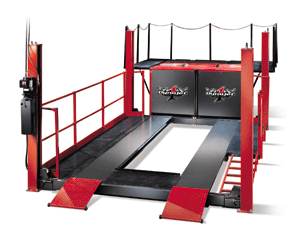 |
Dynojets can also be had in
above-ground configurations such as this double-throw-down unit that
includes a hydraulic lift designed specifically for the dyno.
Photo:
Dynojet Research. |
|
|
A combination of two laws of physics, force equals
mass times acceleration and work equals force times distance, gives us
this equation: W=m X a X d. "W" is the work, in pounds-feet,
the rear wheels are doing, "m" is mass equivalent (the drums),
"a" is acceleration (increasing drive wheel speed) and
"d" is distance (drum circumference). Once we have the work,
we can find horsepower. One horsepower is 550 pounds-feet of work done
in one second so, we divide the work number by the length of time
measured, then divide the number we get from that by 550. To simplify:
we get horsepower by multiplying the mass, acceleration and the
distance, then dividing that product by time multiplied by 550. This can
be expressed by: hp = (m X a X d) ÷ (t X 550).
Torque can be figured by multiplying the horsepower
by a constant, 5252, then dividing that product by the speed at which
the thrust force was measured. Generally, with rear wheel numbers, axle
ratio is not considered in the torque computation. For comparison
purposes, this makes more sense. The computer factors out the axle ratio
by using engine speed data in the torque derivation.
In the real world, the measurements and computations
are not quite that simple, but the complex methods Dynojet Research uses
to apply these laws of physics and their mathematics to accurate
measurement of rear wheel power is a proprietary secret.
Computers Make it Easy
While all this math and physics stuff may bring back
horrid memories of high-school, computer power makes it quite simple and
this simplicity is the beauty of inertia dynamometers.
The newest Dynojet peripheral hardware is intended to
be used with a personal computer running the exclusive "Windows
Performance Evaluation Program" or "WinPEP" software
(current release: v6.03) under the Microsoft Windows 95 or 98 operating
system. WinPEP not only captures dyno measurements and makes the
computations, but it’s also a powerful analytical tool. It can
superimpose power/torque graphs of up to 12 runs or "passes.".
Using it, you can zoom-in on specific parts of the power or torque
curves. You can set custom preferences for graph axis choices such as
power, torque, rpm and wheel speed. You can choose a variety of
different corrections. You can display peak power and torque values,
atmospheric data and other information pertinent to each run as text on
the graph.
WinPEP data can also be printed or exported to a
Windows Metafile or .bmp file. As WinPEP is fairly new, many dyno
operators will have the older, "PEP" v4.x software, a DOS
application not quite as powerful, but sharing some of WinPEP’s
analytical tools. PEP can only graph three dyno runs and it has a lesser
number of corrections. Additionally, the interface is not as intuitive
as that of WinPEP.
The Dynojet CPU is intended for connection through a
serial port to a PC having at least a 100 Mhz., Intel Pentium processor,
16 Mb. RAM and an 800 Mb. hard drive. In world of 750-Pentiums that
seems a bit low-tech, but the needs of WinPEP are satisfied by that
level of computing power.
This CPU and additional peripherals are called the
"DynoWare EX+". It consists of: the CPU Module, a Dynamometer
I/O Module (sends and receives data from the dyno and its hand-held
controller); a RPM Module, (processes RPM data from an inductive pick-up
clipped on a plug wire or other engine speed sensor) and an Atmospheric
Sensing Module (measures absolute pressure, air temperature and humidity
and transmits that data to the CPU). These four modules stack together,
allowing easy upgrades or expansion with options such and Air/Fuel Ratio
Module, for exhaust gas analysis, or an Optical Pick-up, for engine
speed input. Additionally, WinPEP supports both the Pi and CDS data
acquisition systems popular in motorsports which allows graphing of
parameters such as boost pressure, fuel pressure, intake air temperature
(IAT) and spark advance against the power and torque data.
The DynoWare EX+ is capable of some pretty accurate
measurements. Timing accuracy is ±1 microsecond or .000001 sec. It
takes vehicle speed twice per drum revolution with an accuracy of ±.01
mph. It measures engine speed within ±0.1 rpm, temperature within
±0.15°F, pressure within ±0.04 inches of mercury (in/hg.) and
humidity within 1%.
Correct–then Compare
OK. You ran your car on a dyno and its computer spit
out a bunch of power and torque numbers. In fact, you have two sets:
uncorrected, or "raw," numbers and corrected numbers.
Gearheads love to compare numbers. Each dyno is subjected to different
atmospheric conditions. To facilitate comparison, there has to be a
"standard" to which dyno results conform or are
"corrected." In the United States this is usually Society of
Automotive Engineers (SAE) standard J1349 Rev JUN90. Correcting to SAE
J1349 alters the data to make it seem as if it was taken when the
atmospheric pressure was 29.23 in/hg., the temperature 77° F and the
humidly zero.
The degree to which temperature, pressure and
humidity affect power output is constant. If we accurately measure those
parameters at the dyno location, we’ll know the difference between the
atmospheric conditions at the time and location of our test and those of
SAE J1349. That difference is applied to the raw data and the result is
corrected power and torque which we can compare to other data taken
anywhere in the world that is also corrected to J1349.
|
|
The DynoWare EX+ measures and inputs all variables
relating to the correction process. Older Dynojet hardware (an expansion
board in a 286 or better PC running MS-DOS) requires the operator to
measure humidity with the other variables inputted automatically. The
software does the corrections based on the atmospheric data.
The older PEP software (v4.x) corrects only to SAE
J1349. The newest WinPEP (v6.03) corrects to not only J1349, but to
other standards, including "standard corrected", popular with
aftermarket manufacturers (no doubt because it uses 29.92 in/hg and
68°F to get bigger numbers), "EEC", used in Asia and parts of
Europe, and "DIN", used in Germany.
Always ask what correction factor was used to derive
the data when judging various performance products on the basis of dyno
test results. For example: a car I tested recently for Vette
Magazine generates 412rwhp, SAE and EEC corrected, but the same car puts
out 423 rwhp, standard corrected and 425rwhp, DIN corrected.
|
|
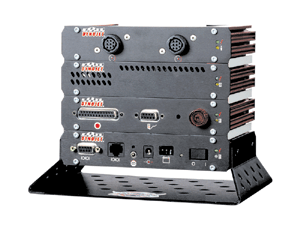 |
The DynoWare EX+ computer.
Stacked
top to bottom are the Atmospheric Sensing, RPM, Dynamometer I/O and CPU
modules.
Photo: Dynojet Research. |
|
|
Cans/Can’ts and Pluses/Minuses
A Dynojet can give you the rear wheel power and
torque output of your car. Well–duh! A test run can done in two ways:
1) wide open throttle in one gear or 2) wide open throttle through
multiple or all gears.
Besides simplicity, accuracy and repeatability, a
great feature of inertia dynos is they get performance data with less
abuse to the car than does a brake dyno. A Dynojet can be used to
evaluate the effects of modifications. It can be used to calibrate fuel
injection systems and spark curves. It can be used to diagnose engine
problems, such as detonation or mismatches between various
modifications. It can help in solving driveline noise and vibration
troubles. It can be used to evaluate the parasitic losses caused by
different types of transmission and rear axle lubricants.
Since inertia dynos have one roller-per-wheel,
overheating the tires and the tendency of cars to try and jump off the
rollers are eliminated. Also, vehicles do not need to be loaded down
against the rollers which also reduces heat build up and increased
frictional losses through the tires.
There are a few things a Dynojet can’t do. Most
importantly, it can’t duplicate a drag strip, thus it cannot directly
predict a car’s e.t. and speed in a quarter mile pass, however, it can
predict trends in a car’s performance. That is: if the car runs well
on an inertia dyno, it’s most likely going to run well on the race
track.
There are exceptions to this and they come with
vehicles that use load tables in their engine controls calibrations to
set the air/fuel ratio. It has been difficult to get specific
information on which cars have this and which don’t, however, our
limited research indicates this is more typical of Ford and Diamler-Chrysler
products than it is of GM vehicles. It is also a problem most likely to
occur if the mass of the vehicle (or combination of vehicles , if the
vehicle in question is towing) is significantly more than the mass
equivalent of the dyno drum.
|
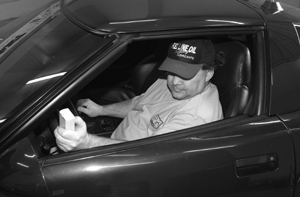 |
| Once you’re ready to make a
pass, all the user needs to control the Dynojet is this hand controller.
The top button enables the computer’s capturing and saving of the run.
The bottom button works the dyno’s air brake. |
|
|
If a lot of data on similar cars’ performances on
both the dyno and the drag strip is accumulated, inertia dynos can come
close to predicting race track performance. For example, a dyno operator
like Kenne-Bell, may have a lot of dyno tests and drag strip passes on a
particular type of car that consistently develops 400 horsepower at the
rear wheels (rwhp) and runs consistent 12.10s at the drag strip. It’s
makes sense to say that a similar vehicle, also putting out 400 rwhp
ought run low-to-mid-12s, as well.
While Dynojet can measure "coast down"
power consumption by a vehicle’s powertrain, they cannot accurately
measure parasitic loss for the purpose of figuring flywheel power output
from rear wheel output. Differences in power losses during acceleration
and deceleration prevent this.
|
|
|
A standard Dynojet 248H has no capability to load the
vehicle with more than the drums’ mass equivalent, however, an option
called "Dynotrac," which adds computer control to the dyno’s
air brake, can load the vehicle to any wheel speed, engine rpm or
percentage of braking force. While Dynotrac enables loading, currently,
the dyno cannot measure torque output in real time because Dynotrac is
simply a proportional air brake controller. At this writing, Dynojet
Research has a strain gauge, necessary to measure torque in real time,
under development. When it becomes available, the 248H will be able to
function as a load cell dyno.
One complaint we hear is about the RPM pickup. It
seems to cause some users problems with waste-spark ignition systems.
For that, Dynojet suggests the user make sure the dyno computer is
grounded to the vehicle and that it’s set to read spark data every
360° of rotation rather than every 720°. The RPM pickup is also
incompatible with newer ignitions that have no spark plug wires or
short, inaccessible wires. The optical RPM pickup is offered as a
solution for that but when Jim Bell interviewed for this story, he told
us both optical and magnetic pickups are time-consuming to set-up such
that they provide accurate data. Clearly, a more simple way of setting
up and obtaining RPM data is something Dynojet Research needs to look
at.
What Kind, How Much, Who Uses Them?
Dynojet makes two inertia dynos capable of testing
four-wheeled vehicles. The 248H, can handle up to 1200 horsepower and
drive wheel speeds up to 200 mph. Its maximum axle weight is 3000 lbs.
so it can be used with virtually all cars and some light trucks. Also
available is the 224, a smaller unit with 500 hp. and 160 mph limits.
There are 248Cs around, too. That was the company’s first dyno capable
of testing four-wheeled vehicles and is now out of production.
|
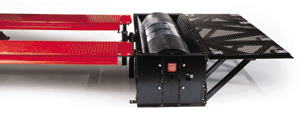 |
Dynojet’s "compact model" is
the 224. It costs less, is easier to install and takes up less space.
The 224 aimed as moderately-sized service shops working with vehicles
generating 500 or less horsepower at the rear wheels.
Photo: Dynojet
Research. |
|
|
Currently, there are about 400 248s or 224s operating
world-wide. A 248H will cost $30,000-$40,000 depending on options and
how the installation is done. The 224 runs $20,000-$30,000 depending on
options and installation. Either model is available as a ground-level,
"pit" installation or an above-ground unit equipped with a
hydraulic, drive-on hoist.
Kenne-Bell was one of the first customers for the
above-ground unit. Jim Bell told us they are great for shops that change
a lot of exhaust parts during test sessions because the drive-on hoist
makes underchassis work between tests easy. He added, the above ground
units are attractive in cases were restrictive building codes or
workplace safety regulations make a "pit" dyno an expensive
and complex option
|
|
|
Several years ago NASCAR’s Winston Cup Technical
Director, Gary Nelson, discovered the Dynojet 248H as a tool to help him
keep all the teams competing equally. It’s now the officially licensed
chassis dynamometer of NASCAR. Also, most major teams in Winston Cup
Racing have their own units. With most of them, no car goes on the truck
for a race if it hasn’t run on the dyno before it leaves the shop.
K&N Engineering, Lingenfelter Performance
Engineering, B&B Fabrication, Doug Rippie Motorsports, Dutweiller
Performance, Kenne-Bell, Flowmaster, Second Street Speed, Motorsport
Technologies and Borla Performance Industries are only a few of the
aftermarket manufacturers and performance tuners whose names often
appear in GMHTP and which use Dynojets in product development and
validation.
An inertia chassis dynamometer can be a tuner’s
secret weapon. It also can tell much about manufacturers’ claims about
products. Jim Bell told us, "I look at the Dynojet as the lie
detector of the industry."
It’s simplicity, accuracy and repeatability make
comparing and contrasting different performance modifications an easy
and sometimes very revealing process. The Dynojet is one hell of a piece
of test equipment. Now, all I gotta do is get one installed in my
garage.
Sources:
|
|
Dynojet
Research
Suite 105
2191 Mendenhall
Las Vegas NV 89031
800.992.4993
www.dynojet.com |
K&N
Engineering
PO Box 1329
Riverside CA 92502
800.858.3333
www.knfilter.com |
|
Kenne-Bell
Hi-Tech Performance Products
10743 Bell Ct.
Rancho Cucamonga CA 91730
909.941.6646 |
|
|







